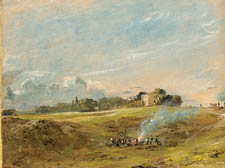|
|
 |
| |

Hampstead Heath, with a Bonfire, c1822 |
The rich skies over Hampstead bought by a wealthy American
Philanthropist Paul Mellon put together one of the most impressive
English art collections outside Europe, including ‘heavenly’ Hampstead, writes Gerald Isaaman
TOILING up the hill to Hampstead, Daniel Defoe recorded that it was “so close to heaven” that only those fit enough to take the altitude, albeit a mere 440 feet above sea level, could possibly live there.
John Keats too was obsessed by Hampstead’s heavenly nature, declaring: “I will clamber through the clouds and exist,” while the painter John Constable added his own appreciation of the heights above London where he spent his summers “skying” on Hampstead Heath.
“You can never be nubilous – I am the man of clouds,” he wrote of his experimental exercises that enriched his landscapes and made his painting dramatically real and so remarkable in capturing nature.
You only have to visit the Victoria and Albert Museum to see the magic of Constable’s skies, but if you take a trip to the Royal Academy you can now view rarer Constables – and so much else – that come from the collection of the late American philanthropist Paul Mellon, who died in 1999.
They have been assembled as part of a worthy celebration to mark the centenary of the birth of Mellon, an American from Pittsburgh with a passion for British art, and the money to indulge in it in the toughest of auction rooms.
He may have grown up lonely and insecure, as many rich men do, but he long ago secured his legitimate legacy with a lifetime spent collecting some 1,900 paintings, 250 sculptures, 50,000 prints and drawings, plus 35,000 books presented to Yale University.
They form the largest and most impressive display of British art outside Europe. So a trip to the Royal Academy is now essential if you wish to enjoy a taste of some wonderful works by such English masters as Stubbs, Turner, Gainsborough and Reynolds, let alone Samuel Palmer, William Blake and Paul Sandby.
Constable too, of course, in particular his doom-laded landscape of the rude ruins of 13th-century Hadleigh Castle, from 1829, where your eye can roam for miles to the horizon, as if on wings, as the windy clouds sail by.
But my eye fell, naturally, on two small yet familiar Hampstead pictures, now to be seen in the grandeur of the Royal Academy. One is dated 1822 and is called Hampstead Heath, with Bonfire, a scene near Jack Straw’s Castle at the summit of the Heath which, naturally, embodies the sky.
The landscape is brought alive not so much by the flames of the bonfire, as the tiny figures alongside. Constable uses a deft flick of black paint to create them virtually out of thin air, thus bringing the scene to life. Constable’s economy of line proves beyond doubt his immaculate touch in rising above the mundane.
The second picture takes us down Haverstock Hill, past the old cottage where the radical right-wing journalist Sir Richard Steele hid out from his debtors in 1712, the Hampstead coach centre stage with the dome of St Paul’s beyond its likely destination.
It’s a painting that travels, albeit away from Hampstead, yet here we have Constable giving us a new bastion on the skyline, one that remains still so familiar today.
Indeed, it was the view of St Paul’s from the rear window of Constable’s home in Well Walk, where his wife Maria died from TB in his arms, that he described as the finest in Europe. And that sense of destination is there again in this work that Mellon equally found so tempting, along with one of Constable’s sublime floating sky studies.
But don’t go to the Royal Academy’s Sackler wing just for Constable. There are other exhibits to treasure in your memory – especially Stubbs’s extraordinary zebra painting that remained unsold in his studio until his death – before these 150 exhibits disappear from view on January 27. Grab the opportunity to enjoy the Mellon.
|

|
 |
|
 |
|

